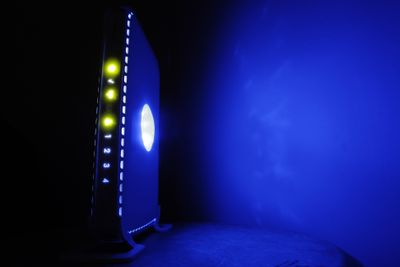Night lights, too bright
LED panels’ glow causes evening frustrations

NEW YORK — Twinkle, twinkle, little Internet router. And cell phone. And digital video recorder. And cable modem. And game console. And power strip. And TV — even though it’s turned off.
Turn off the lamps in a living room or bedroom today, and chances are good the room will still be aglow with the tiny diode lights of a half-dozen gadgets.
They can be useful indicators of what state a gadget it is in, or where it is, but they also bug people who’d rather not have lights shining in their faces when they’re trying to sleep or watch movies.
To sleep in a dorm room full of electronics at Cornell University, Rafael Garcia has covered some lights with black tape. He turns his laptop upside-down and places a mouse pad and a picture of his girlfriend on his desktop computer to block its lights. His electric toothbrush has to come out of its charger, or it will blink through the night.
Unplugging the gadgets stops them from disturbing the darkness, but an unplugged laptop or toothbrush also doesn’t charge. Other devices, such as computers, take time to shut down and start up.
“It’s gotten way, way, worse, especially in the last year or two,” said Shawn Therrien, a Los Angeles computer programmer. “Every single thing we buy has little neon-blue flashing lights on it. … Turn the light off and they shine like beacons.”
Therrien’s bedside nemesis is an alarm clock that doubles as an iPod docking station.
“It lights up like the Fortress of Solitude,” he said, likening it to Superman’s headquarters of glowing crystals. He tamed it with 12 strips of black tape.
Tom Hespos, a partner in an advertising firm in New York, counted six glowing devices in his bedroom. One is an alarm clock with a blue backlight so strong he has to put a pillow between it and him.
And don’t get him started on his Internet router, which has blinking blue light-emitting diodes.
“Whoever sees that glow through my window must think I’m keeping aliens in my spare room,” he said.
Blue LEDs have become particularly popular for electronics, and that’s part of the problem. In dim light, our eyes are more sensitive to colors at the blue end of the spectrum, so blue LEDs look brighter, said Mariana Figueiro, of Rensselaer Polytechnic Institute’s Lighting Research Center in Troy, N.Y.
When blue LEDs became available in 1993, they first showed up only in high-end equipment.
Andy Logan, of Frog Design in San Francisco, tries to steer manufacturers toward more subtle light designs rather than having the diodes shine like flashlights.
But he doesn’t recommend designing products so that people can turn off the lights without turning the entire gadget off. The lights often indicate when a device shouldn’t be unplugged, such as when a hard drive is writing data.
Outside the bedroom or dorm room, more blue LEDs might actually be a good thing — researchers are exploring whether they can be used to keep people alert and awake.
Scientists have discovered that a light-sensitive layer of the eye, separate from the part that allows us to see, sends signals to the body that affect rhythms of wakefulness and sleep.
That layer is also more sensitive to blue light than to any other color, said George Brainard, director of the light research program at Thomas Jefferson University in Philadelphia.
He has funding from the NASA-affiliated National Space Biomedical Research Institute to study whether blue-light treatment can help keep astronauts more alert. Figueiro is helping the Navy figure out whether blue light can help submariners adjust to their watch schedules.
For now, researchers don’t believe the low levels of blue light emitted by gadgets is enough to change our sleep patterns.
“Some people are very, very sensitive,” Brainard said, “so I’d hate to say never.”